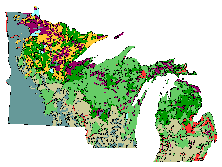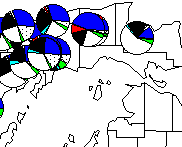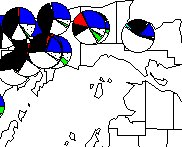 
 The LUHNA Book! |
  |
|
by
Kenneth L. Cole Forest Stearns Glenn Guntenspergen Karen Walker
The landscapes of the Great Lakes region incorporate dynamic interactions between the grasslands of the Great Plains, the eastern deciduous forests, and the boreal forests of North America. Patterns of climatic circulation give this region remarkably varied climate despite the fairly uniform topography. In the 500 km from southern Lake Michigan to Michigan's upper peninsula, growing season length drops from 180 to 90 days. Natural fire frequency drops from several fires per decade in the tall-grass prairies to several or no fires per 1,000 years in the maple-beech forests of Michigan. The Great Lakes themselves, the largest accumulation of freshwater lakes in the world, create "lake effect" climate zones, with more moderate temperature fluctuations complicating the environmental responses to climate change by interacting with the climate and acting as migration barriers. Urban development in the Great Lakes states is also variable, ranging from dense urban areas such as Chicago to remote wilderness such as Isle Royale and the Boundary Waters Canoe Area. Much of the area has been converted to commercial farmland or forests, but much also remains relatively undisturbed in wildlife reserves, undeveloped wetlands, national forests, and national parks. Documenting the extent and timing of the historical ecological change in such a diverse region presents a scientific challenge. This chapter demonstrates the use of two different methods of reconstructing the historical vegetation of the Great Lakes region. Nineteenth century survey data are useful for reconstructing the forests that existed at the start of the period of European settlement, when natural ecosystems began to be greatly altered by an industrialized society. But because many impacts may have preceded these surveys and because natural ecosystems often have cyclic or directional natural changes caused by climate, fire, or plant succession, longer-term data are often required in order to place these nineteenth century "presettlement" ecosystems into a larger perspective. We use records of fossil pollen from the Great Lakes region to examine the relationship between this nineteenth century survey data and the vegetation record for the last 1,000 years.
The General Land Office Survey (GLO) of the mid-nineteenth century produced data that can now be used to classify the type of forests that existed at that time (Hutchison 1988). Surveyors delineated township boundaries using "bearing" and "witness" trees. The trees were chosen in a systematic manner, identified by species, recorded in log books, and blazed (marked) to enable relocation of the survey boundaries. Today, 150 years later, the blazed trees are almost all gone, but the data recorded during the survey remain. These data are a valuable record of mid-nineteenth century forests and can be used to develop maps of presettlement forest distribution.
These maps demonstrate that although much of the region is less impacted than other areas to the south and east, extreme environmental changes have occurred in Great Lakes forests over the last 150 years. The severity of these changes can be better appreciated when they are examined in the longer term perspective of the last 1,000 years.
The Great Lakes states offer uniquely detailed data on historic and paleoecological environments over the last 10,000 years. This pilot project, though, will describe only data covering the most recent 1,000 years. The sediments at the bottom of many lakes are repositories of information on environmental history, containing abundant fossil pollen, diatoms, ostracodes, cladocerans, charcoal, and sediment chemistry. The North American Pollen Database (a public domain database developed by the National Geophysical Data Center) contains data from over 150 sites in the Great Lakes states. An equivalent number of records, many not yet in the public database, have recently been entered into a regional database for Wisconsin and Michigan (M. B. Davis, University of Minnesota, unpublished data). This database greatly extends the detail in the northern portion of these states beyond what was previously available (Webb et al. 1983).
Many pollen samples are taken from a single lake, usually by extracting a core of the lake sediment. Each pollen sample is aged by dating portions of the core with radiocarbon or lead isotopes. Although some studies have produced records as detailed as one sample per decade, this kind of resolution over a 10,000-year period would be prohibitively expensive, requiring the analysis of 1,000 samples. Most sediment cores are sampled less extensively, producing one sample to represent every 50 to 200 years. Each pollen sample can yield up to 50 different pollen types, each type representing a different plant group. Pollen analysis is especially useful in the eastern deciduous forests of North America because many important tree species produce their own distinctive pollen type. The data can be used to detect past changes at a single site, or multiple sites can be combined to reconstruct past migrations of ecosystems or plant species over the landscape (Davis et al. 1986). Because of the detailed information in each sample, summarizing the data over a region is difficult, as only the predominant pollen types can be presented. Often, complex statistical analyses are used to reduce the myriad pollen types into indexes representing similar species groups. Some pollen types, such as the goosefoot family (Chenopodiaceae) and the sagebrush group (Artemisia spp.), grow well in recently disturbed areas, such as at the edges of farm fields. These pollen types are excellent indicators of disturbances in ecosystems. Other taxa, such as beech (Fagus grandifolia), grow in old-growth forests that have not been disturbed for centuries. The abundant fossil pollen records from northern Wisconsin and Michigan provide a record of past forest changes which is extremely detailed. Selected sites were used to compare the modern land cover (1970-90; Fig. 6-4a) with land covers of the presettlement era (1830-60; Fig. 6-4b) and of about 1,000 years ago (Fig. 6-4c). Pollen from sediment cores at each site (represented by pie charts in the figures) furnishes recent and Holocene fossil records, many of which extend back to the retreat of the Pleistocene glaciers about 14,000 years ago (12,000 B.C.) in the south to 11,000 years ago (9,000 B.C.) in the north. Differences between the presettlement and modern surface samples reflect the forest changes occurring between the mid-nineteenth century GLO survey and recent U.S. Forest Service survey (Fig. 6-1c). Although almost all of these samples were taken in undisturbed forested areas, the percentage of disturbance indicators (goosefoot family and sagebrush) increased, especially in the South where much nearby forest was converted to nonforest. In the North, birch usually increased at the expense of white pine as a result of logging. Beech decreased in all but the least disturbed areas.
For this chapter, we have contrasted the amount of vegetation change from 1,000 years ago to the presettlement time horizon (a period of about 850 years) with the amount of change taking place between the presettlement horizon and the current era (about 150 years). The data from each pollen record were analyzed by using a statistical method that plots each sample in a multidimensional space using the percentage values for each pollen type in the sample. The distances between the three samples at each site in this multidimensional space (Squared Cord Distance) were then calculated. The results demonstrate that the average amount of change in pollen types was 2.4 times greater during the 150 years since settlement than during the previous 850 years (Fig. 6-5). This difference is statistically significant (P = 0.0015 for a one-tailed t-test following a log-normal conversion). Recent changes also have a larger range of variability; some sites have changed radically, while others have changed little since settlement. The magnitude of these recent changes can be fully appreciated by considering that no records were taken from cultivated fields or urban areas. Most of the sampling sites were in relatively unimpacted forests which would most likely have been recorded in Fig. 6-1c as "unchanged." The fossil pollen results support the comparisons of presettlement GLO and modern forest survey data from the first part of this project. The mid-nineteenth century GLO data could not be used to represent general presettlement conditions if forests were changing rapidly throughout the last several hundred years. The results of this pollen analysis suggest that rates of forest change prior to settlement were minor when compared to rates of change after settlement (Cole 1995). As a result, GLO survey data do represent a generalized presettlement condition. More detailed analysis of the fossil pollen demonstrates environmental changes due to fluctuating climate and other factors prior to settlement, but these changes are generally of a much lower magnitude than those occurring since European settlement. These fossil pollen data are important in providing a regional vegetation history at a resolution unobtainable through any other method. The use of GIS permits the overlaying of digitized data on topography, climate, forest cover, and pollen data, allowing for analysis of past forest changes and its relation to soils, topography, or proximity to the lakes. The power of this fossil pollen data is that the last several thousand years of environmental history can be examined, providing a more meaningful record of change than the relatively simplistic comparison of presettlement versus postsettlement. Directions and past rates of change can be reconstructed in a dynamic manner investigating past natural changes resulting from shifts in climate, plant migration, and plant succession. These changes can be compared with the recent anthropogenic changes to evaluate the nature and magnitude of change resulting from these very different forces.
The data presented in this chapter were produced through funding from the Western Great Lakes Global Change Research Program of the National Park Service and National Biological Service (now USGS Biological Resources Division). Julie Blackett compiled and analyzed the fossil pollen data, which were produced by many other researchers. Additional assistance was received from the Paleorecords of Global Change Research Training Group (RTG) at the University of Minnesota. Randy Calcote provided statistical assistance, and helpful comments were received from Tom Sisk, Scott Anderson, Daryl McGrath, and anonymous reviewers.
Presettlement and Contemporary Vegetation Patterns Along Two Navigation Reaches of the Upper Mississippi River
Text-only |
||||||||||||||||||||









